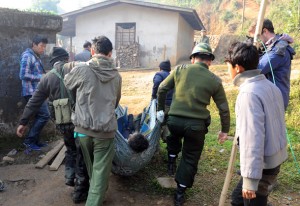Burma Must End Offensives and Dialogue with Ethnic Armed Groups for a National Political Settlement
By Burma Partnership • January 14, 2013 We have entered a new year after a year and a half of fighting between the Burma Army and the Kachin Independence Army (KIA). Since the war started, it is estimated that up to 100,000 people have been displaced. These refugees are living in Burma’s coldest area and receive very little humanitarian assistance as aid workers, including those from the United Nations, are often denied access to them.
We have entered a new year after a year and a half of fighting between the Burma Army and the Kachin Independence Army (KIA). Since the war started, it is estimated that up to 100,000 people have been displaced. These refugees are living in Burma’s coldest area and receive very little humanitarian assistance as aid workers, including those from the United Nations, are often denied access to them.
The intensity of war against the KIA has reached a crisis point after the Burma Army launched a series of air strikes in late December. After exposure of footage on the internet of the air strikes the government had no choice but to admit the use of military jets and attack helicopters in carrying out targeted attacks. Today, the Burma Army injured and killed civilians in its attack on Laiza, the KIA headquarters. Yet the government still insists that it is not launching offensives but acting in self-defence. It is now unthinkable how far the Burma Army might go to win this war.
Lt-Gen Yawdserk, leader of Shan State Army-South, which still faces attacks by the Burma Army even after signing ceasefire, said they have a ceasefire only “with the government, but not with the Army”. It is not surprising since President Thein Sein’s two orders to halt offensives in Kachin State were never honored. This is precisely why the KIA insists on “political talk” before “ceasefire talk” because they had 17 years of ceasefire already and they know well how little these talks mean that they simply don’t believe in them anymore.
Although destruction of public transport infrastructure is the only reason given so far by the government as to why it is at war with the KIA, all the other ethnic armed groups that used to face similar accusations are aware that this is just an excuse and that there is more that motivates the Burma Army.
Awareness of the situation in Kachin State among the general public, civil society and the international community has grown fast with several calls to end the war. Another round of protests calling for the end of conflict were held in Rangoon on 1 January, while hundreds of Kachin people from China protested in Nanbang, a Chinese border town next to Kachin State’s Laiza, to show solidarity. More protests were held in Bangkok, Washington, and Toronto. Ban Ki-moon called to stop “actions that could endanger the lives of civilians or promote further conflict” and the US and UK said they are deeply concerned by the situation.
The United Nationalities Federal Council (UNFC) stated that its members will no longer engage in ceasefire or peace talks with the government on an individual basis and called on President Thein Sein to prove that he can show effective leadership and influence over the Burma Army. However, the Kachin Independence Organization (KIO) and certainly Kachin communities worldwide, as illustrated in their follow-up letter to Daw Aung San Suu Kyi, might feel somewhat frustrated by the little effort made by the people in the right positions. Daw Suu has publicly said it is “up to the government” whether she could intervene.
Extended offensives using excessive force seem to be the Burma Army’s strategy to completely wipe out the KIA. Yet what the Burma Army should have realized long ago is that defeat of the KIA does not defeat Kachin armed resistance. The same goes for all other ethnic armed groups. KIA commander Gwan Maw, in an interview with The Voice Weekly, said that the KIO (the political wing of the KIA) agrees that there should be only one chief of Burma’s armed forces. He explained that the KIO wants the regime to form a Union Army under which the KIA is willing to reorganize its troops, and they want another conference like Panglong, an agreement made in 1947 between several ethnic nationalities and the newly independent government of Burma guaranteeing autonomy and equality. It is very simple what they ask for yet fighting goes on.
In fact, all ethnic armed groups as well as ethnic civil society and communities have been calling for another Panglong-like conference outside the framework of the Parliament. Almost all ethnic conflicts in Burma are motivated by the breaking of the promises made in the Panglong Agreement by successive military regimes. Thein Sein’s government, with the willingness and endorsement of the Burma Army, must genuinely commit to a similar conference to end all ethnic-related conflicts and find a political settlement to guarantee the autonomy and equality of all ethnic nationalities once and for all.
Tags: Armed Conflict, Burma Army, Burma Partnership, Kachin Independence Army, Kachin Independence Organization, Kachin StateThis post is in: Blog
Related PostsBurma Army Displays Blatant Disregard for 21st Century Panglong Peace Process
On Union Day, Reappraisal of the Peace Process is Needed
ရွမ္းျပည္တိုိးတက္ေရးပါတီ၊ ရွမ္းျပည္တပ္မေတာ္ SSPP/SSA ထုတ္ျပန္ေၾကညာခ်က္
Time for the Government to Accept the Reality of Human Rights Problems, Take Effective Measures and Move Forward
Kachin Region: War Torn Displaced Village Profiles









 All posts
All posts